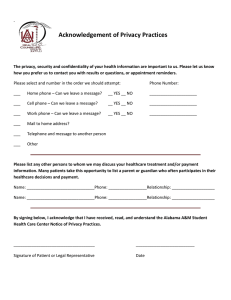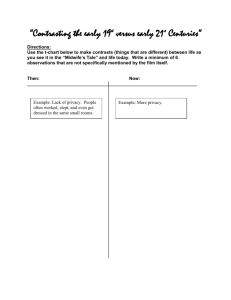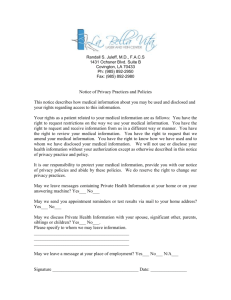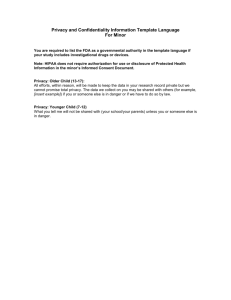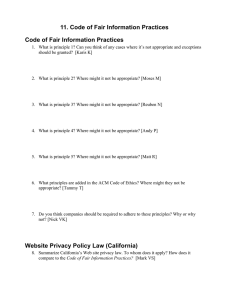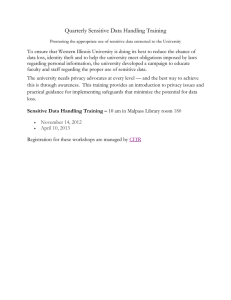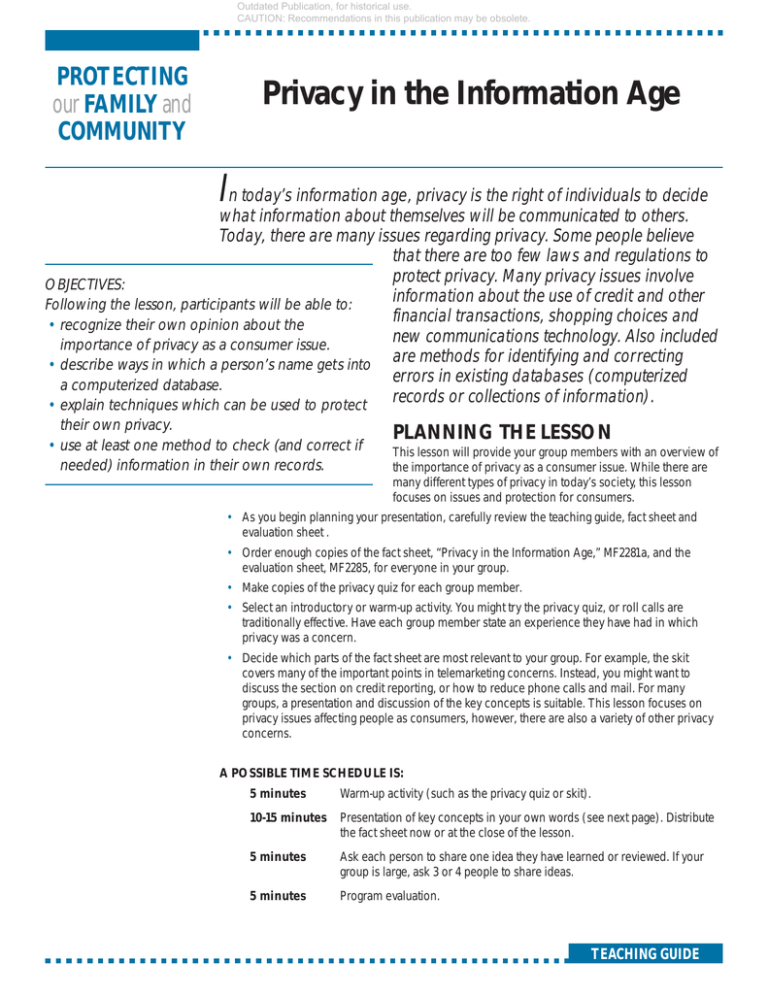
Outdated Publication, for historical use.
CAUTION: Recommendations in this publication may be obsolete.
PROTECTING
our FAMILY and
COMMUNITY
Privacy in the Information Age
In today’s information age, privacy is the right of individuals to decide
what information about themselves will be communicated to others.
Today, there are many issues regarding privacy. Some people believe
that there are too few laws and regulations to
protect privacy. Many privacy issues involve
OBJECTIVES:
information about the use of credit and other
Following the lesson, participants will be able to:
financial transactions, shopping choices and
• recognize their own opinion about the
new communications technology. Also included
importance of privacy as a consumer issue.
are methods for identifying and correcting
• describe ways in which a person’s name gets into
errors in existing databases (computerized
a computerized database.
records or collections of information).
• explain techniques which can be used to protect
their own privacy.
• use at least one method to check (and correct if
needed) information in their own records.
PLANNING THE LESSON
This lesson will provide your group members with an overview of
the importance of privacy as a consumer issue. While there are
many different types of privacy in today’s society, this lesson
focuses on issues and protection for consumers.
• As you begin planning your presentation, carefully review the teaching guide, fact sheet and
evaluation sheet .
• Order enough copies of the fact sheet, “Privacy in the Information Age,” MF2281a, and the
evaluation sheet, MF2285, for everyone in your group.
• Make copies of the privacy quiz for each group member.
• Select an introductory or warm-up activity. You might try the privacy quiz, or roll calls are
traditionally effective. Have each group member state an experience they have had in which
privacy was a concern.
• Decide which parts of the fact sheet are most relevant to your group. For example, the skit
covers many of the important points in telemarketing concerns. Instead, you might want to
discuss the section on credit reporting, or how to reduce phone calls and mail. For many
groups, a presentation and discussion of the key concepts is suitable. This lesson focuses on
privacy issues affecting people as consumers, however, there are also a variety of other privacy
concerns.
A POSSIBLE TIME SCHEDULE IS:
5 minutes
Warm-up activity (such as the privacy quiz or skit).
10-15 minutes
Presentation of key concepts in your own words (see next page). Distribute
the fact sheet now or at the close of the lesson.
5 minutes
Ask each person to share one idea they have learned or reviewed. If your
group is large, ask 3 or 4 people to share ideas.
5 minutes
Program evaluation.
TEACHING GUIDE
Outdated Publication, for historical use.
CAUTION: Recommendations in this publication may be obsolete.
KEY CONCEPTS
The growth of information technolog y:
• has created both convenience and potential risk for consumers.
• enables more information about more people to be collected
and shared among government and business groups.
• has made trading personal information an expanding and
profitable industry.
• raises new concerns about defining and protecting privacy.
Consumers can take steps to protect their privacy by:
• learning how and when privacy is protected by law and when
it is not.
• knowing how personal information is being collected, by
what groups, and for what purposes.
• providing only essential information to the government and
businesses.
• knowing how to “opt-out” of direct marketing, Internet and
telecommunications lists.
• monitoring the accuracy of credit, medical, social security
and other records.
IDEAS FOR COMMUNITY
SERVICE ACTIVITIES
In planning activities, be careful to avoid a biased opinion.
Recognize that there is a need for record keeping and for some
sharing of information among companies and agencies. Promote
a balance of different perspectives. Contact your county extension
agent for ideas about other publications and resources.
• Sponsor a series of consumer privacy tips on the radio or
television, or in the local newspaper. Examples are available
from your county extension agent.
• Prepare a booth or display on issues relating to consumer
privacy for a community event.
• Work with the library on a special display. See if the library
has (or can get) reference books dealing with privacy issues.
• Invite a speaker or a panel of speakers to talk about how they
deal with information that requires some privacy safeguards.
You might choose someone from a local retail store (especially one which grants credit), a local credit bureau (if your
community has one), a bank or other financial institution, a
hospital records manager, an attorney, an extension agent, or
a journalist who writes about privacy issues.
• In addition to speaking at a county or area-wide event, you
might ask the spokespersons if they are willing to be
interviewed by the newspaper.
• Present information about privacy issues to high school
classes or community youth groups. The educational kit,
“Who Knows?” is available from Katey Walker’s office, and is
listed as a reference on the fact sheet.
TEACHING GUIDE — 2
RESPONSES TO QUIZ QUESTIONS
1. There is more concern today about privacy. The development
of information technology makes it easier for groups to obtain
and compile financial and other data about individuals.
2. The limits of privacy are changing. Part of the lack of privacy
occurs because computers can rapidly match names with
addresses and phone numbers and financial transactions. In
earlier times this sort of information was not easily shared.
3. There are lots of different opinions. Many consumers worry
that they have little control over their personal information.
Some consumers like the convenience of home shopping,
while others think much direct marketing is an invasion of
privacy. Many businesses regard information as a resource
that can be used to develop and sell new products and
services. It also helps them make decisions about credit,
employment and insurance. Many government agencies
need information to carry out their work. The right balance
needs to be found between an individual’s right to privacy
and business and government’s need to know.
4. Consumer viewpoints are varied. Some people like to get
marketing information, while others would like to eliminate
what they view as junk mail.
5. Consumers concerned about privacy can reduce the amount
of information they provide to the government or businesses.
6. It is smart to contact a credit bureau to check on your credit
records. Corrections can be made if you find inaccurate data.
7. Many mailing lists provide information about where you
travel, what products you purchase, whether you own your
home, etc. Companies can target potential customers more
efficiently. For example, a company selling storm windows or
aluminum siding would prefer to have a non-renter list.
8. Consumers who want to reduce telephone calls or mail
advertisements can use a variety of ways to get their names
off lists. The seller can be contacted directly, or consumers
can call the Mail and Telephone Preference Services of the
Direct Marketing Association. The consumer can also use
blocking devices so that any potential marketers you call
cannot receive your phone number automatically.
Prepared by Doris “Katey” Walker, Extension Specialist, Family
Resources and Public Policy, School of Family Studies and
Human Services, Kansas State University.
Developed in consultation with the Kansas Association for Family
and Community Education Educational Committee.
Outdated Publication, for historical use.
CAUTION: Recommendations in this publication may be obsolete.
PROTECTING
our FAMILY and
COMMUNITY
Privacy in the Information Age
SKIT: A Quiet Evening at Home
Two friends, Meg and Peg, are discussing the
problems they have when trying to have a quiet
family evening at home.
The scene is Meg’s living room.
Meg
Hello Peg, it’s good to see you. I hope we have
a few minutes to talk. There always seem to be
so many interruptions.
Peg
Ah, Meg. It’s so good to have someone to talk
with—someone who really understands my
problems.
Meg
Good friends who understand are important.
Peg
I’ve been trying to set aside some time in the
evening for family activities, but we keep
getting interrupted by the telephone.
Meg
Who is calling? Can’t you tell your friends or
other relatives that you’d rather have them call
at a different time? They’ll understand that you
need some peace and quiet for family time—or
just for yourself.
Peg
Oh no, it’s not that. It’s not even calls about
work. The calls are from people trying to sell
us something. I wish I knew how they got our
phone number, and how they know so much
about me.
Meg
You know, the extension agent and a volunteer
shared some interesting information at our
work’s lunch-and-learn session last week. I
learned that telemarketers get your number and
information about you from computerized
mailing lists. Companies develop these lists
from databases of information about people.
They can also get your number from telephone
books and street address directories.
Peg
Meg
Gee, Meg, I never thought about that. Is it a
profitable business for them?
Yes, and getting bigger and more profitable
everyday. We never used to think very much—
let alone worry—about privacy. Now computers
help match names, phone numbers and
addresses with what we like to buy, and
marketing people know how to aim their sales
talks or advertisements directly to us.
Peg
It’s kind of scary, isn’t it? And these phone
calls certainly interfere with other things we
want to do. Isn’t there anything I can do?
Meg
Sure, Peg. At the meeting they gave us ideas on
ways we can protect our privacy as a consumer.
It’s important to know that we give away a lot
of information without realizing it. When we
enter a sweepstakes contest, we usually give
our phone number. Take a good look at the
income and lifestyle information companies ask
for when we fill out a warranty card. Lots of it
isn’t necessary, and we can leave it blank. Do
you have your name, address and phone
number printed on your checks? That’s helpful
for identification, but lots of people can see
them.
Peg
I never thought of that.
Meg
Another thing you can do is ask companies not
to use your name on mailing or phone lists. You
can even “opt-out” of many lists. This involves
contacting the Direct Marketing Association
and asking to have your name removed from
the companies that belong to that group—or ask
the company itself. When a telemarketer calls,
you can then tell them not to call you anymore.
Peg
You mean I don’t have to listen to all these
sales pitches?
Meg
That’s right. I guess some people like to be
called at home, but when it interferes with our
activities there are many things we can do to
protect our privacy and reduce the number of
calls we get.
Peg
Thanks, Meg. Maybe if we try some of these
ideas we can have a quiet evening at home
after all. I guess I need to learn more about
privacy and be a bit more assertive.
Meg
I think we all do. It sounds like something we all
need to watch in the future.
SKIT
Outdated Publication, for historical use.
CAUTION: Recommendations in this publication may be obsolete.
PROTECTING
our FAMILY and
COMMUNITY
Privacy in the Information Age
What Do You Think? A Quiz About Privacy
The purpose of this quiz is to help group members
focus on the topic of the lesson. You may want to
use these questions as the basis for covering the
material in the lesson. Be sure members know this
is not a test. Some responses are on the last page of
this teaching guide.
Directions: Check “Agree” if you mostly agree with the
statement or check “Disagree” if you mostly disagree.
1. Privacy issues are an increasing concern because of the growth of information technology.
❏ Agree
❏ Disagree
2. The limits of privacy are changing because more information about more people can be gathered
and shared.
❏ Agree
❏ Disagree
3. Consumers, businesses and government agencies have different views of about what information
should be held private and what can be shared.
❏ Agree
❏ Disagree
4. What one consumer regards as “junk mail” may be viewed as a “convenience” by another consumer.
❏ Agree
❏ Disagree
5. Consumers can help protect their privacy by providing only essential information to the government
or businesses.
❏ Agree
❏ Disagree
6. Consumers need to check on their credit records to insure accuracy.
❏ Agree
❏ Disagree
7. Direct marketing companies use personal information to develop mailing or telephone lists to reach
potential customers.
❏ Agree
❏ Disagree
8. There are ways to “opt-out” of direct marketing and telecommunications services.
❏ Agree
❏ Disagree
This and other publications from Kansas State University are available on the World Wide Web at http://www.oznet.ksu.edu.
Contents of this publication may be freely reproduced for educational purposes. All other rights reserved. In each case, credit Doris “Katey” Walker, “Privacy in the Information Age,” Kansas State University, Sept. 1997.
Kansas State University Agricultural Experiment Station and Cooperative Extension Service, Manhattan, Kansas
MF-2281a
September 1997
Issued in furtherance of Cooperative Extension Work, acts of May 8 and June 30, 1914, as amended. Kansas State University, County Extension Councils, Extension Districts, and United States Department of
Agriculture Cooperating, Richard D. Wootton, Associate Director.
It is the policy of Kansas State University Agricultural Experiment Station and Cooperative Extension Service that all persons shall have equal opportunity and access to its educational programs, services, activities,
and materials without regard to race, color, religion, national origin, sex, age, disability, or other nonmerit reasons. Kansas State University is an Affirmative Action employer. These materials may be available in
alternative formats.
File Code: Consumer Education—4
CS 9/97—1.1M
QUIZ

